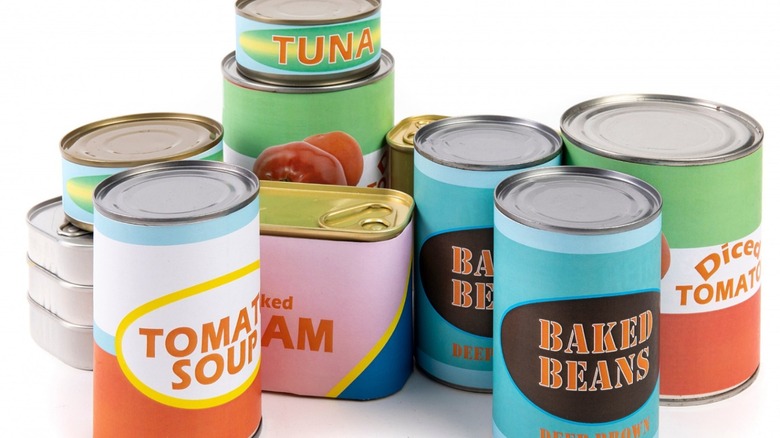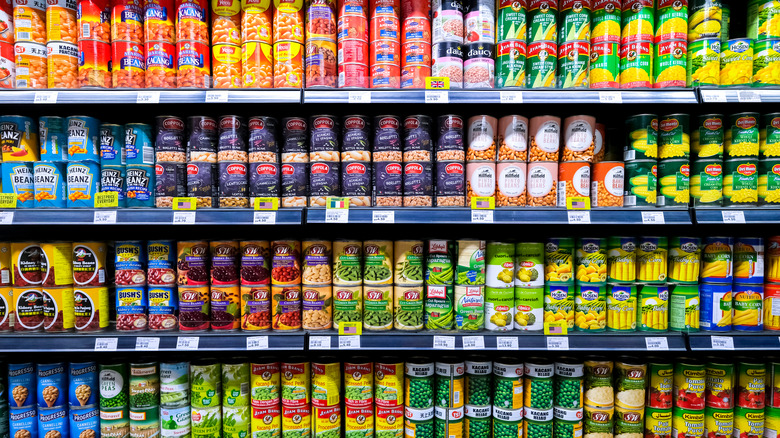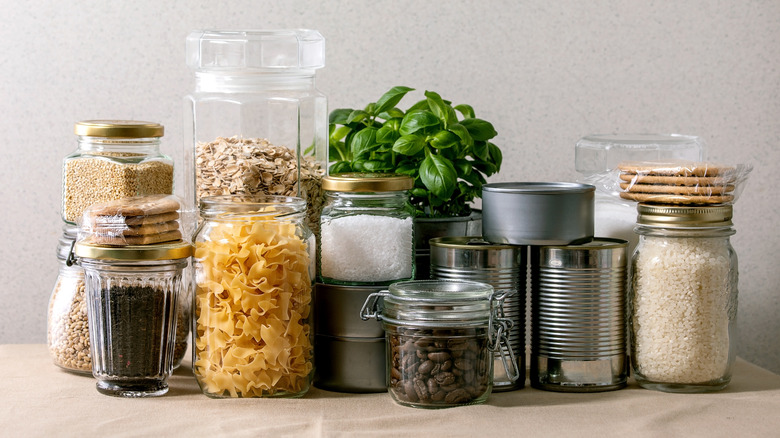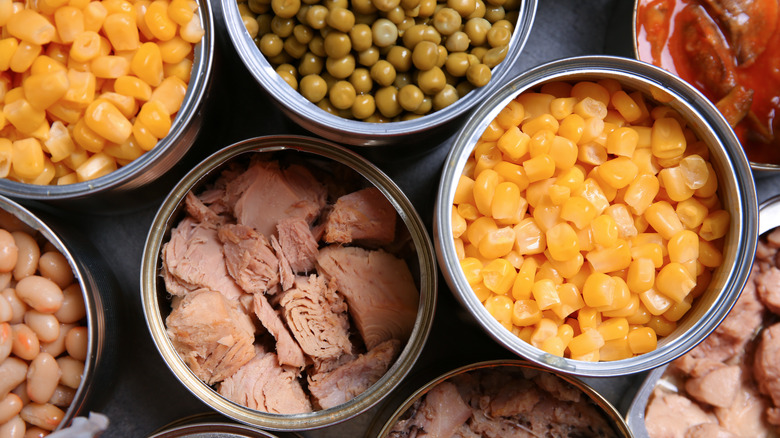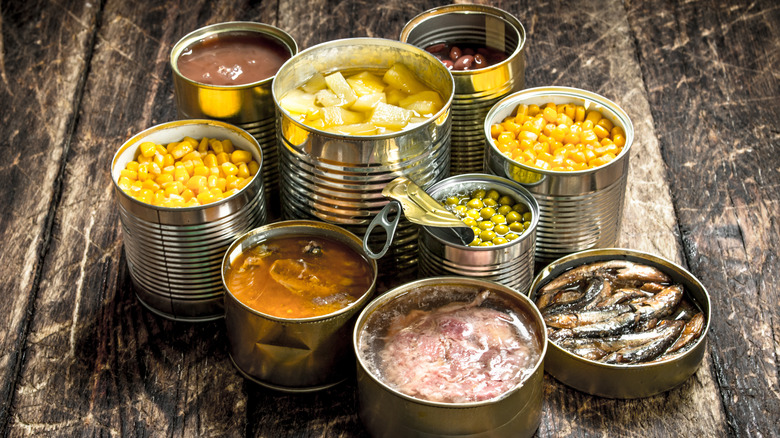The Canned Food Controversy That Changed History
Prior to the advent of refrigeration, the task of preserving food was paramount. History encapsulates this desire, noting that "from pickling and salting to smoking and drying, humans have been finding ways to make food last longer since prehistoric times." The origins of proper canning — ensuring that the food was correctly preserved and was entirely safe to consume — changed the future of food forever. While the developments helped to bring canning to the forefront, a scandal nearly toppled the entire empire.
French chef Nicolas Appert is widely acknowledged as the originator of canning or bottling. Kitchn notes that Appert "began experimenting with preservation during the late 1700s, and he successfully preserved foodstuff," attributing this to the removal of air (or oxygen) within the storage vessel. Fascinatingly enough, a country-wide competition was held by the French government, with a prize of 12,000 francs to the winner, primarily in order to discover a way to properly preserve and conserve food for soldiers. Oftentimes, the soldiers were at sea for months with no means of acquiring fresh, nutrient-rich food. As the National Agriculture Library notes, Appert won the competition in 1809, but his invention was still in the early stages.
Fun fact: as noted by Food Ingredient Facts, Appert also created the bouillon cube.
The progression of canning
Appert furthered his research, nothing that once the food was in a vessel that was "corked ... and sealed off with a wax seal," it would keep for a considerably longer amount of time. The Spruce Eats notes that Appart's winning design took 15 years to perfect and "heat-processing food in glass jars," using both wire and wax to ensure complete sealing. However, Appert's glass jars were very heavy, would sometimes explode, and were inconsistent. Shortly thereafter, tin soon became a preferable material for canning and preservation.
Many people and corporations were involved in the proliferation of canning in later years, including Peter Durand, inventor of the tin, Robert Ayars, who opened the first cannery in America, John L. Mason who patented the mason jar, and the Ball Corp., which created glass jars to promote home canning (via USDA).
History notes that canning gained popularity in the late 1800s and early 1890s, bolstered by companies such as Campbell's and Heinz, and today, "a double-seam machine can safely seal more than 2,000 cans a minute." This is impressive as some of these canned foods can last for almost 30 years.
Is canning safe?
How Stuff Works sums up the basics of the canning process stating "because most bacteria can't survive in extreme heat, once the food inside sealed cans reaches a certain temperature, the bacteria dies, and an enclosed, sterile environment is created." Did you know that one-hundred-year-old cans found in shipwrecks were, amazingly, still sealed and safe? Not very appetizing or appealing, certainly, but an incredible testament to the science of canning and the strides that scientists of the era were able to innovate.
Food Ingredient Facts notes that a surgeon in 1814, who was living on a naval vessel at the time, stated that canned (or tinned) food was "a most excellent restorative to convalescents, and would often, on long voyages, save the lives of many men who run into consumption at sea for want of nourishments after acute diseases."
Alternately, improper canning can cause horrific outbreaks of illness. Due to this, home canning can be very precarious. How Stuff Works notes that many canned goods tend to be heavy in sodium, but that the main drawback to canning is unquestionably botulism. The food-borne botulism toxin is poisonous and harmful to health. As a matter of fact, just one gram of this toxin is enough to cause millions of deaths, which sums up just how dangerous improper canning can be.
A canning scandal
As noted by the BBC, a scandal at the Royal Clarence Victualling Yard in Portsmouth almost demolished the entire industry. In efforts to combat the deaths and illnesses experienced by soldiers and seamen due to malnutrition, starvation, and food-borne illness, there was a pointed focus on canning and food preservation developments.
In January 1852, however, meat inspectors were astonished at what they found at a canning company, "instead of perfectly preserved beef, they found putrid meat so rotten that the stone floors needs to be coated with chloride of lime to mask the stench." The "beef' itself was also suspect and seemed to be an amalgamation of organs from undisclosed animals. 264 cans were condemned that day, and as the news spread, a nationwide inspection was ordered, revealing various Navy depots to have meat that was inedible. And while you can't tell while sealed in a can, these are the warning signals of meat that has gone bad.
The supplier of the problematic cans was found to be a Romanian canning company who was clearly eschewing the proper stipulations and rules of the canning industry of the time. Instead of being shut down, the owner of the company was reprimanded, but the damage was done, and canning took on a negative reputation for years to come.
The redemption of canning and its current place in the kitchen
Companies began launching PR campaigns in order to extol the positivity of properly handled canned meats and foods, both for soldiers and seaman, as well as for homemakers and families. Surprisingly, it was condensed milk that did the trick. The milk was such a success that it helped to revert the outrageously negative reputation that canning had taken on. The overall availability, as well as the reliability and consistency of canned, condensed milk, as opposed to the quick spoils of fresh milk, was a huge "win" for the canning industry (via BBC).
The only other issue? The first can opener, although created in the 1860s, didn't become widespread until 1925, which put a dent in the mainstream success of the cans. The New Deal and the wars also greatly increased the production of cans, and soon people began to celebrate the fact that canning "[allowed] food to be harvested in season and eaten out of season," which was incredibly impactful, according to BBC. Of course, Warhol's depiction of a Campbell's tin can of soup became synonymous with the industry in 1962, and the rest is history.
Nowadays, refrigerators and freezers, plus microwaves and modern-day cooking vessels, have minimized the need for a total focus on cans, but they're still a constant in the majority of home kitchens.
